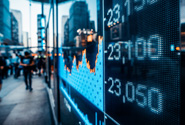Global equities remain resilient. Julius Baer’s balanced, currency-hedged and diversified investment solution offers compelling return potential in today’s volatile market environment – without full exposure to market risk. With an 18-month investment horizon, it represents a genuine alternative to the bond market.
Market opportunities in dynamic times
As 2025 draws to a close, global equity markets continue to defy expectations. Both US and European indices have benefited from improving economic sentiment, delivering solid returns. The key question for investors now is how to position portfolios wisely in an environment that remains uncertain and volatile – yet full of opportunity – to capture attractive returns without being fully exposed to market risk.
Balancing stable returns and reduced risk
With yields on traditional bonds continuing to fall, investor interest in alternative sources of income is rising. This broadly diversified investment idea provides the opportunity to stay engaged in international equity markets while maintaining a substantial risk buffer. Julius Baer’s investment approach incorporates a mechanism that cushions market setbacks up to a clearly defined level, while at the same time generating fixed, regular income. In turbulent markets such as today’s, this can represent an appealing alternative to the bond market.
A structured global solution
With an 18-month term and broad exposure to four leading international equity indices – the SMI, Euro Stoxx 50, S&P 500 and Nasdaq 100 – this attractive investment solution combines a sizeable risk buffer against market declines with the potential to earn guaranteed fixed monthly returns. Particularly appealing in the current environment is the callable feature, which allows for early redemption by the issuer and, in turn, a higher return. Issued in CHF, EUR and USD, the solutiont is currency-hedged, allowing you to align your investment precisely with your preferred reference currency.
More product details:
IMPRINT
This content constitutes marketing material and is not the result of independent financial/investment research. It has been produced by Bank Julius Baer & Co. Ltd., Zurich, which is authorised and regulated by the Swiss Financial Market Supervisory Authority FINMA.
This content is intended for information purposes only and does not constitute advice, an offer or an invitation by, or on behalf of, Julius Baer to buy or sell any securities, securities-based derivatives or other products or to participate in any particular trading strategy in any jurisdiction.
Julius Baer does not accept liability for any loss arising from the use of this document.
This content may include figures relating to simulated past performance. Past performance, simulations and performance forecasts are not reliable indicators of future results.
For further details about risks and suitability, as well as important legal information, please consult the following link: IMPORTANT LEGAL INFORMATION

 Login
Login







